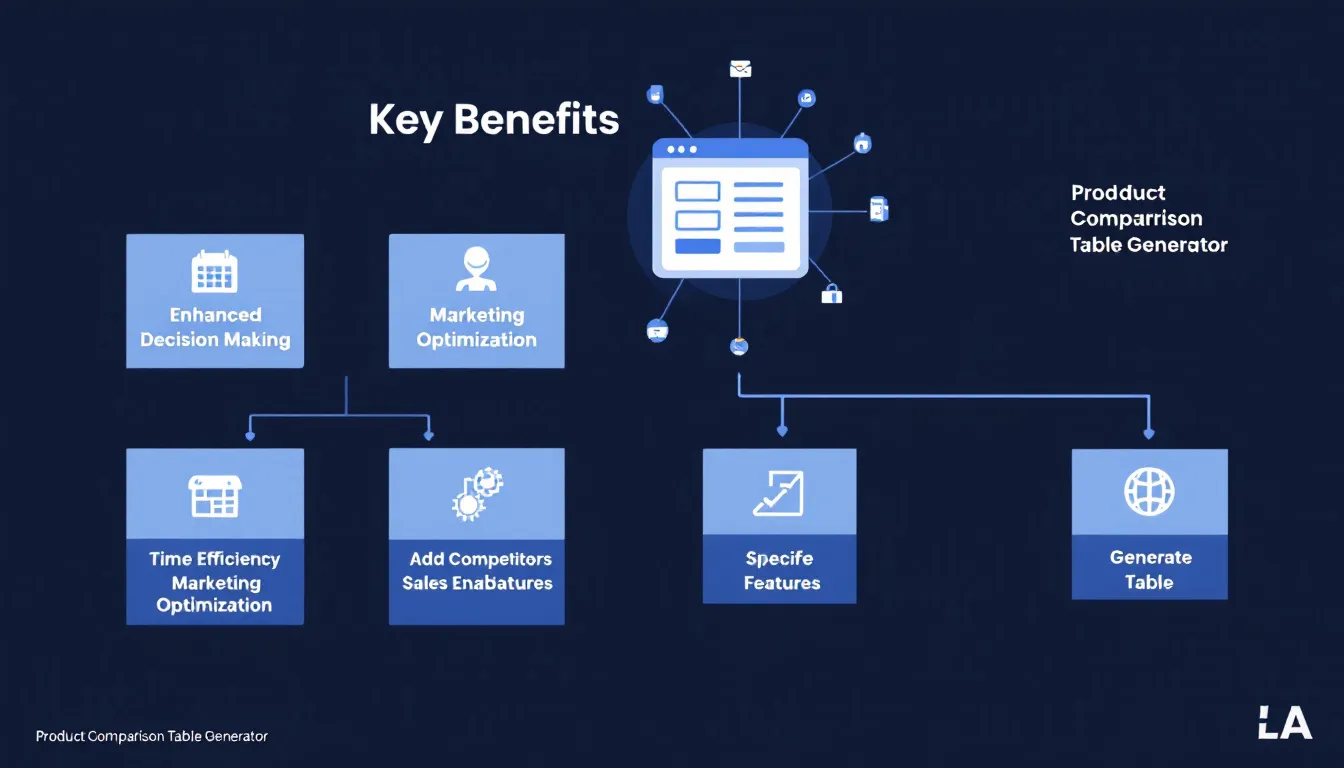Is this tool helpful?
How to Use the Product Comparison Table Generator Effectively
Follow these steps to create an insightful and clear product comparison table using this tool:
- Your Product Name: Enter your product’s name here. For example, “EcoSmart Home Controller” or “SwiftTask Manager”.
- Main Competitors: List your key competitors separated by commas. Examples: “BrightHome Hub, TaskFlow Pro, ManageEase”.
- Target Audience: Describe who your product serves best. For instance, “Home automation enthusiasts” or “Freelancers managing multiple projects”.
- Key Features and Benefits (Optional): Highlight your product’s primary features to compare. Example features include “Voice control integration, Energy monitoring, Multi-device support”.
Introducing the Product Comparison Table Generator
This tool creates structured comparison tables that help you analyze your product side-by-side with competitors. It organizes complex product information into a simple, readable format that emphasizes important differences and advantages. Using it, you can quickly spot what sets your product apart, tailor marketing messages, and support sales efforts with clear data.
Why Use This Product Comparison Tool?
- Clarity: Easily compare features and benefits across multiple products.
- Efficiency: Save time by automatically generating professional tables instead of manual formatting.
- Insight: Understand how your product fits into the competitive landscape.
- Sales Support: Equip your sales teams with clear talking points and comparison data.
Practical Uses for the Product Comparison Table Generator
Market Positioning and Analysis
Use the comparison tables to:
- Identify where your product leads or falls behind competitors
- Spot opportunities in customer targeting and messaging
- Clarify your product’s unique selling points clearly
Sales and Marketing Application
Leverage the generated tables to:
- Build persuasive sales presentations focused on competitive advantages
- Create engaging marketing materials that highlight your product’s key benefits
- Address common buyer questions by showing fact-based comparisons
Example Use Cases
Case 1: Mobile App Feature Comparison
- Product Name: “QuickFit Tracker”
- Competitors: “HealthSync, FitPulse, MoveWell”
- Target Audience: “Fitness beginners and casual athletes”
- Key Features: “GPS tracking, Personalized workout plans, Nutritional guidance, Social sharing”
Case 2: B2B Software Platform Comparison
- Product Name: “DataSecure Vault”
- Competitors: “SafeKeep Pro, LockBox Enterprise, SecureCloud”
- Target Audience: “Corporate IT departments”
- Key Features: “End-to-end encryption, Multi-factor authentication, Compliance reporting, Real-time alerts”
Frequently Asked Questions About Product Comparison Tables
How can I make my product comparison more effective?
Focus on features and benefits that matter most to your target customers. Highlight what truly differentiates your product from others in the market.
Should I include pricing details in the comparison?
Include pricing only if it’s a major selling point and clearly available. Otherwise, emphasize feature differences and value delivered.
How often should I update the comparison table?
Update whenever you introduce new features or when your competitors change their offerings significantly.
Can I customize the comparison criteria?
Yes, this tool lets you focus on specific features and benefits relevant to your market and customer priorities.
Best Practices for Creating Impactful Product Comparisons
1. Select Relevant Features
Choose features that:
- Directly address customer needs and pain points
- Highlight areas where your product excels
- Demonstrate clear advantages over competitors
- Are meaningful to the target audience
2. Use Accurate and Current Information
Maintain credibility by ensuring all data and features are up to date and verified.
- Check competitor updates regularly
- Review your own product’s enhancements before each update
- Keep language objective and fact-based
3. Communicate Value Clearly
Highlight benefits rather than just listing features. Use clear, benefit-oriented language and real-world examples where possible.
- Focus on what each feature means for the user
- Include use case scenarios
- Address ROI and productivity gains when relevant
Maximizing the Impact of Your Product Comparison Tables
Visual Clarity and Formatting
Present your comparison table with clear visuals to make it easier to scan and understand.
- Use consistent fonts and spacing
- Create hierarchies with headings and bold text for key points
- Consider using icons or checkmarks to indicate feature availability
Organize Information Logically
Structure features and benefits from fundamental to advanced, grouping related items together.
- Begin with core functionalities
- Follow with optional or premium features
- End with unique selling points and extras
Important Disclaimer
The calculations, results, and content provided by our tools are not guaranteed to be accurate, complete, or reliable. Users are responsible for verifying and interpreting the results. Our content and tools may contain errors, biases, or inconsistencies. Do not enter personal data, sensitive information, or personally identifiable information in our web forms or tools. Such data entry violates our terms of service and may result in unauthorized disclosure to third parties. We reserve the right to save inputs and outputs from our tools for the purposes of error debugging, bias identification, and performance improvement. External companies providing AI models used in our tools may also save and process data in accordance with their own policies. By using our tools, you consent to this data collection and processing. We reserve the right to limit the usage of our tools based on current usability factors.







